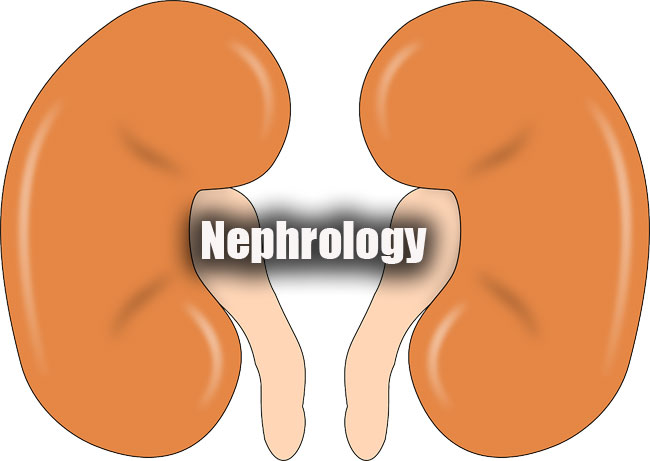Nephrology Questions and Answers
Nephrology Questions and Answers paper for the written examination is given below. Candidates who are looking for Nephrology exam Questions and Answers paper can find in this section. The applied candidates who are getting prepared for the Nephrology can view this page for the Nephrology Last Ten Years Questions and Answers Papers. Download the Nephrology Questions and Answers & Solutions & make it as a reference for your exam preparation.

Take advantage of these Nephrology Questions and Answers Papers in a proper manner to get qualifying Marks. Last 5 years Nephrology Questions and Answers Papers provided here. Candidates who are applied for the above exam can check and download the Nephrology Questions and Answers Papers from here.
Questions and Answers on Nephrology
1. Anti-GBM disease is an autoimmune condition of known pathogenesis but unclear etiology. All of the following statements are true regarding its pathogenesis, except :
(1) It is an autoimmune disease against alpha 3 chain of type III collagen.
(2) Shock wave lithotripsy may rarely lead to GBM antibodies and clinical disease in susceptible individuals.
(3) Approximately 50% of kidney recipients with Alport syndrome after receiving kidney from healthy donor develop anti-GBM antibodies; only a few of these patients have graft failure because of anti-GBM disease.
(4) Anti-GBM antibody disease has a strong positive association with the HLA-DR15 haplotype, which is found in more that 80% of patients with anti-GBM antibody disease.
2. In Renal biopsy with immunoflourescence staining looking for immune deposits, all are true findings of the suggested disease, except :
(1) Membranous nephropathy granular subendothelial IgG
(2) Focal segmental glomerulosclerosis non-specific trapping in focal scars
(3) Minimal change disease – non- immune deposits.
(4) IgA nephropathy – mesangial IgA deposition.
3. In IgA nephropathy, all of the followings indicate a bad prognosis, except :
(1) Male gender
(2) Presence of diastolic hypertension.
(3) Elevated serum levels of immunoglobulin A
(4) Presence of persistent microscopic hematuria.
4. In case of patients with IgAN; which of the following renal biopsy parameters is strongly predictive of favourable outcome to immune-suppression ?
(1) Mesangial hypercellularity
(2) Endocapillary hypercellularity
(3) Segmental glomerulosclerosis
(4) Tubular atrophy/interstitial fibrosis.
5. A 23 year old male patient underwent renal biopsy for evaluation of nephritic syndrome. The light microscopy tissue specimen revealed 13 glomeruli. 3 glomeruli were globally sclerosed. The remaining glomeruli showed mild increase in mesangial cellularity and matrix, few glomeruli showed segmental endocapillary cellularity with intracapillary neutrophil margination. 3 (23%) glomeruli showed segmental tuft sclerosis and 9 (67%) showed cellular crescent formation. Tubular atrophy and interstitial fibrosis was observed in 15% of sampled cortex. On Immunofluorescence staining strong (3+) staining was observed for IgA. Please calculate the Oxford-MEST-C score for this patient.
(1) MIEISITOC2
(2) MIEISITOCI
(3) MIEISITOCO
(4) MOEISITICI
6. In acute interstitial nephritis; all are true, except :
(1) The commonest cause is drug induced.
(2) Blood eosinophila is seen only in 30 % of cases, yet eosinophiluria is seen up to 70% of cases.
(3) Should be suspected in any non- oliguric acute renal failure.
(4) Predominant infiltration of the tubulo-intersitium with eosinophils on renal biopsy is more suggestive of a viral etiology.
7. Chronic interstitial nephritis may be caused by all of the followings, except :
(1) Chronic exposure to aristolochic acid
(2) Wilson’s disease
(3) Hanta virus infection
(4) Chronic ingestion of phenacetin
8. Which of the following is the least likely cause of rapidly progressive Glomerulonephritis ?
(1) Memebranous nephropathy
(2) AntiGBM disease
(3) Post-infectious glomerulonephritis
(4) SLE
9. Recurrent UTI is common in postmenopausal females. Which of the following intervention is least likely to be effective in reducing frequency of recurrent infections ?
(1) Fluid intake of at least 3 liters per day
(2) Regular intake of cranberry juice
(3) Topical estrogen cream application
(4) Avoidance of spermicidal jelly
10. A 77-year-old man presents to the emergency department complaining that for the past 24 hours, he has been unable to void. The patient reports that he has had this problem intermittently and that he has been diagnosed with benign prostatic hyperplasia. He has an upper respiratory infection and has been taking over-the-counter pseudoephedrine. The patient also reports that a year ago, he was admitted to the hospital for unstable angina. At that time, his creatinine level was 1.1 mg/dl. In the emergency department, the patient’s serum creatinine level is determined to be 4.2 mg/dl. Regarding this patient’s renal failure, which of the following statements is false ?
(1) Renal ultrasound should show bilateral hydronephrosis, suggesting obstructive uropathy as the cause of acute renal failure.
(2) The use of pseudoephedrine has contributed to the development of urinary obstruction.
(3) Urinalysis is commonly abnormal in obstructive uropathy; an abnormal result supports the diagnosis of obstruction.
(4) Obstruction impairs the ability of the kidneys to concentrate the urine and thus contributes to a polyuric state.
11. Which of the following statements is false regarding the characteristics of renal anemia ?
(1) The red cells produced are usually normochromic and normocytic.
(2) There is usually no associated leukopenia or thrombocytopenia.
(3) The reticulocyte count is usually around 40,000 to 50,000 per microliter of blood.
(4) Red blood cell life span is normal.
12. Which drug has’ been’ shown to reduce mortality in CKD patients with dilated cardiomyopathy and systolic heart failure ?
(1) Atorvastatin
(2) Digoxin
(3) Carvedilol
(4) Metoprolol
13. Many drugs are implicated in pathogenesis of kidney diseases. Which of the following combination is not true in regard to drug induced nephropathy ?
(1) Cisplatin and renal loss of sodium
(2) Cyclosporin and chronic interstitial nephritis
(3) Lithium and nephrogenic diabetes insipidus
(4) NSAIDS and minimal change nephropathy.
14. Which of the below mentioned factors is not associated with increased urinary potassium excretion ?
(1) Avid sodium re-absorption.
(2) High urinary flow rate.
(3) Metabolic acidosis
(4) Excess poorly absorbed anions like ketones and phosphate.
15. AKI has been’ described as a complication following the administration of oral sodium phosphate solution as a bowel cathartic in preparation for colonoscopy and bowel surgery. Which of the following fact is not true in this regard ?
(1) The pathogenesis likely relates to a transient and significant rise in serum phosphate concentration leading to intratubular precipitation of calcium phosphate salts that obstruct the tubular lumen and cause direct tubular damage.
(2) Acute phosphate nephropathy is mainly seen in patients with pre-existing CKD with oncomitant volume depletion.
(3) Renal biopsy in cases of acute phosphate nephropathy show diffuse tubular injury with abundant calcium phosphate deposits.
(4) Most of patients present with oliguric AKI 3-5 days after administration of phosphate | enema.
16. In a clinically stable patient, which of the following biochemical or hematologic abnormalities is suggestive of chronic kidney disease (CKD) rather than acute kidney injury (AKI) ?
(1) Calcium 3.5 mmol/I
(2) K 7.5 mmol/|
(3) Hemoglobin 10.7 g/dl
(4) Creatinine 13.5 mg/dl
17. Which of the following is not an established risk factor for cardiovascular disease in patients with advanced chronic kidney disease ?
(1) Inflammation
(2) Smoking
(3) Dyslipidemia
(4) Hyperhomocysteinemia
18. Which of the following variables is not needed to calculate eGFR from the CKD-EPI formula ?
(1) Age
(2) Weight
(3) Race
(4) Sex
19. On reviewing a recently completed 24-h ambulatory BP recording on a 52-year-old man with hypertension and stage 2CKD (eGFR 76 ml/min per 1.73 m2), it is noted that the mean night time systolic BP (SBP) is about 5% less than the mean daytime SBP. Which one of the following is true regarding the relationship between diurnal BP variation assessed with ambulatory BP monitoring and CKD ?
(1) A nocturnal fall in mean SBP 10% occurs only in patients with elevated 24 h SBP levels
(2) Non-dipping does not appear in patients with CKD until the GFR has fallen below approximately 30 ml/min per 1.73 m2
(3) Non-dipping has been shown to be associated with the presence of CKD in patients with type 1 but not T2DM
(4) Patients with nocturnal fall in SBP of less than 10% have a more rapid decline in GFR compared with those who are.
20. Isolyte-P is commonly used intravenous fluid in paediatric population. Which is of the following parameters is true regarding its composition ?
(1) Sodium 23 meq/L
(2) Potassium 25 meq/L
(3) Calcium 2 meq/L
(4) Acetate 29 meq/L
| Practice Set | MCQs |
| Quiz | Questions and Answers |
21. Which statement is most accurate with regard to the correction of anemia in CKD patient ?
(1) It is likely to be associated with an acceleration of renal disease progression.
(2) It is likely to reduce the rate of albumin excretion in the urine.
(3) Raising the hemoglobin level to normal will lead to regression of left ventricular hypertrophy.
(4) Strong RCT evidence of a beneficial effect on cardiovascular morbidity and mortality is lacking.
22. Hypernatremia is considered when plasma Na+ concentration is greater than
(1) 135
(2) 140
(3) 145
(4) 150
23. Patient on regular hemodialysis is receiving erythropoietin, but his Hb is still low. There is no evidence of active or past infection. He is on oral iron. What is the next step in his management ?
(1) Give higher doses of iron tablets
(2) Give IV iron
(3) Give folic acid
(4) Check for antibodies against erythropoietin
24. What is believed to be mainly responsible for late kidney graft loss ?
(1) Hypertension and hyperlipidemia
(2) New-onset diabetes after transplantation
(3) Recurrence of primary disease
(4) HLA alloantibodies
25. Anterograde pyelography; which one is true ?
(1) It is the injection of a contrast media into kidney through the bladder and ureters.
(2) Itis usually done blindly.
(3) Much more difficult and hazardous in a non-obstructed kidney.
(4) Poorly outline the collecting system.
26. A 55-year-old man who has received hemodialysis for 15 years presents with deteriorating discomfort in both shoulders. Past medical history included bilateral carpal tunnel decompression. What is the most likely diagnosis ?
(1) Beta 2 microglobulin amyloidosis
(2) Gout
(3) Pseudogout
(4) Polymyalgia rheumatica
27. Factional excretion of sodium (FENa) is very usefulness marker to distinguish pre-renal AKI from ATN. However, in certain conditions FENa of >1% may be seen even in cases of pre-renal AKI. Which of the following pre-renal AKI conditions are associated with FENa > 1% ?
1. Prerenal AKI in patients receiving diuretics,
2. Patients with metabolic alkalosis and bicarbonaturia.
3. Patients underlying CKD.
4. Multiple myeloma with cast nephropathy
5. Villous adenoma with diarrhea
6.
(1) 1,2,3
(2) 1,3,5
(3) 1,2,4
(4) 2,3,5
28. Drug induced hyponatremia is not associated with which of the following drugs ?
(1) Cefditoren
(2) Sertraline
(3) Quetiapine
(4) Cyclophosphamide
29. Which of the following is not true regarding Hepatitis-B Nephropathy ?
(1) Mainly seen among children from endemic areas with evidence of vertical transmission.
(2) Membranous Nephropathy is most common histological lesion.
(3) Without treatment most of children develop ESRD in next 10-20 years.
(4) Lamivudine treatment has been shown to be effective in reduction of proteinurea.
30. Which histological lesion is commonly seen in patients infected with hepatitis C virus ?
(1) Membranoproliferative glomerulonephritis type
(2) Membranoproliferative glomerulonephritis type 2
(3) Membranoproliferative glomerulonephritis type 3
(4) Diffuse proliferative glomerulonephritis
31. Sensitization to alloantigen can occur during the following conditions :
(1) Pregnancy
(2) Blood transfusion
(3) Transplantation
(4) All of the above
32. Long-term ingestion of large quantities of analgesics has been associated with chronic interstitial nephritis and papillary necrosis. Which of the following fact is not true regarding analgesic nephropathy ?
(1) This entity was recognized 5-7 times more frequently in women than in men.
(2) Urinary tract malignancy develops in as many as 8% to 10% of patients with analgesic nephropathy, typically after 15 to 25 years of heavy use of analgesics.
(3) Risk of malignancy was more closely related to ibuprofen containing combination pills as compared to other NSAIDs combinations.
(4) Characteristic findings on non contrast computed tomographic (CT) scans include : Small kidneys, with bumpy renal contours and papillary calcifications.
33. A 42-year-old woman presents with nausea, vomiting, and left flank pain with radiation to the groin; these symptoms have persisted for 3 days. A helical CT scan reveals a stone in the left ureter. On the basis of urinalysis and serum chemistries, a diagnosis of type Renal Tubular Acidosis (RTA) is made. Which of the following is NOT consistent with type 1 RTA?
(1) Serum HCO3 14 meq/L with anion gap of 12.
(2) Serum Potassium 2.9 meq/L.
(3) Urine pH 4.5
(4) Urinary calcium phosphate crystals.
34. Which of the following is not risk factor for renal stone formation ?
(1) Hypercalciuria
(2) Hyperoxaluria
(3) Hypercitraturia
(4) Hyperuricosuria.
35. A 75-year-old woman with diabetes and hypertension is admitted to the hospital with nausea, vomiting, and abdominal pain. At admission, laboratory values include a blood urea nitrogen (BUN) measurement of 18 and a plasma creatinine measurement of 0.5 mg/dl. As part of her workup, she undergoes a contrast-enhanced CT scan of the abdomen. During the first 48 hours of the hospital stay, repeat laboratory studies reveal a plasma creatinine level of 1.1 mg/dl. Which of the following statements is false regarding estimates of this patient’s glomerular filtration rate (GFR) ?
(1) A low baseline plasma creatinine value may lead to an overestimation of GFR because of decreased muscle mass in this elderly patient.
(2) The change in plasma creatinine level of 0.6 mg/dl represents an approximately 50% decrease in the patient’s GFR.
(3) The use of drugs such as cimetidine and trimethoprim increase plasma creatinine levels without affecting true GFR.
(4) The patient’s ideal body weight correlates inversely with GFR.
36. A 60-year-old man who presented with fatigue and bone pain is found to be anemic and thrombocytopenic. Radiographs demonstrate osteolytic lesions in several thoracic vertebrae and the left femur. Serum chemistries reveal a creatinine level of 1.2 mg/dl, a calcium level of 11.5 mg/dl, a total protein level of 11 mg/dl, and an albumin level of 3.2 mg/dl. On bone marrow biopsy, there is replacement of normal marrow with sheets of plasma cells. Urinalysis is unremarkable, but 24-hour urine study reveals proteinuria of 2.0 g/day. Which of the following statements regarding this patient’s proteinuria is true ?
(1) The likely underlying pathology involves a structural abnormality of the filtration barrier that results in loss of negatively charged proteins.
(2) It is likely that the results of the 24-hour urine study are falsely elevated because the urine dipstick test is sensitive for most protein species, including albumin and paraproteins.
(3) The proteinuria reflects an overproduction of normally filtered proteins, which overwhelms the reabsorptive capacity of the tubules.
(4) The patient’s degree of proteinuria and spectrum of clinical findings is consistent with the nephrotic syndrome.
37. Endocrinal abnormalities are common in chronic renal failure. All of the following statements are true, except :
(1) Hyperprolactenemia may be seen but unfortunately many cases don’t respond to bromocryptine.
(2) The half-life of insulin is shortened.
(3) Amenorrhea is common in females.
(4) Loss of libido in both sexes is very common.
38. A 36-year-old hypertensive man develops macroscopic hematuria 3 days after the onset of pharyngitis. The patient’s brother had a history of poststreptococcal glomerulonephritis at age 6 after a strepto-coccal infection of the throat. What is the most likely explanation for this patient’s hematuria ?
(1) Poststreptococcal glomerulonephritis
(2) Minimal change disease
(3) IgA nephropathy
(4) Henoch-Schonlein Purpura (HSP)
39. The number of ureteric constrictions along its course includes
(1) one
(2) two
(3) three
(4) four
40. A 58-year-old man known to have nephrotic syndrome presents to the emergency department. For several days, he has been experiencing low back pain and for the past several hours, he has been experiencing hematuria and shortness of breath. The patient is tachypneic, with an oxygen saturation of 92% on 4 L of oxygen via nasal cannula. A CT angiogram reveals pulmonary thromboembolism. Which of the following statements is true in this patient, regarding renal vein thrombosis (RVT) ?
(1) RVT is most frequently associated with idiopathic and secondary membranous nephropathy; of these patients, 30% may have RVT.
(2) Classical presentation is acute lower back pain, hematuria, and renal insufficiency.
(3) Doppler ultrasonography is the most common modality used in the diagnosis of RVT.
(4) For patients with RVT, a 6-month course of warfarin is indicated.
41. Which of the following statements regarding Polyarteritis Nodosa (PAN) is true ?
(1) Serologic tests for PAN are diagnostic; most patients exhibit antibodies against serine protease 3 and myeloperoxidase.
(2) The pathogenesis of PAN is unclear, although there appears to be an association with hepatitis C infection.
(3) ACE inhibitors and angiotensin receptor blockers. (ARBs) should be used cautiously in patients with PAN because renal involvement may produce a functional equivalent of RAS.
(4) In approximately 90% of patients with PAN, remission is achieved with high-dose steroids.
42. A 54-year-old man presents with a 4-day history of low-grade fever and confusion. He was previously healthy. His physical examination is significant for pallor and ecchymoses. Laboratory studies reveal a hemoglobin of 7.6 g/dl, a WBC of 8,200/µl, and a platelet count of 12,000/µl. The peripheral blood smear shows schistocytes and a decreased number of platelets. For this patient, which of the following statements regarding thrombotic microangiopathies (TMAs) is true ?
(1) When plasma sactivity of ADAMTS-13 is elevated, von Willebrand antigens predominate; those antigens bind to platelets and cause aggregation and thrombi in the small vessels.
(2) A presumptive diagnosis of thrombotic thrombocytopenic purpura (TTP) is often based on the presence of thrombocytopenia, schisto-cytes, and prolonged prothrombin time (PT) and Partial Thrombo-Plastin Time (PTT).
(3) Hemolytic-uremic syndrome (HUS) is characterized by platelet ageregation and the presence of large von Willebrand multimers.
(4) The most common clinical presentation of antiphospholipid syndrome (APS) is arterial thrombosis.
43. A 21-year-old college student reports abdominal pain, bilateral ankle and knee pain, bloody urine, and a worsening rash that began on his lower legs and has spread to his trunk. On examination, the patient is afebrile, his blood pressure is 120/80 mm Hg, and his pulse is 76 beats/min. Skin examination reveals raised, indurated, purple coalescing papules on his anterior shins, lower legs, and abdomen. Urinalysis shows 2+ protein with RBC casts on microscopic examination. Stool guaiac results are positive; CBC is normal, with a normal WBC differential; creatinine is 0.8 mg% and negative antinuclear antibodies. Skin biopsy results reveal an intense neutrophilic infiltrate surrounding dermal blood vessels, confirming leukocytoclastic vasculitis. Which of the following is most likely to be true about this man’s condition ?
(1) Renal biopsy is diagnostic for Henoch-Schonlein purpura.
(2) Polyclonal IgG deposits on skin biopsy confirm Henoch-Schonlein purpura.
(3) The extent of renal involvement is the most important prognostic factor.
(4) Prednisone and cyclophosphamide therapy should be started as soon as possible.
44. Investigations in patient with methanol poisoning are likely to reveal
1. Normal anion gap
2. Metabolic acidosis
3. Oxalate crystals in urine
4. High osmolal gap
(1) Only 2, 4 are correct.
(2) Only 2, 3, 4 are correct.
(3) Only 1, 2, 4 are correct.
(4) Only 1, 2, 3 are correct.
45. Which anatomical structure prevents a horse shoe kidney from ascending to a level above umbilicus ?
(1) Length of ureters
(2) Inferior mesenteric artery
(3) Weight of isthmus bridging both kidneys
(4) Left renal artery



